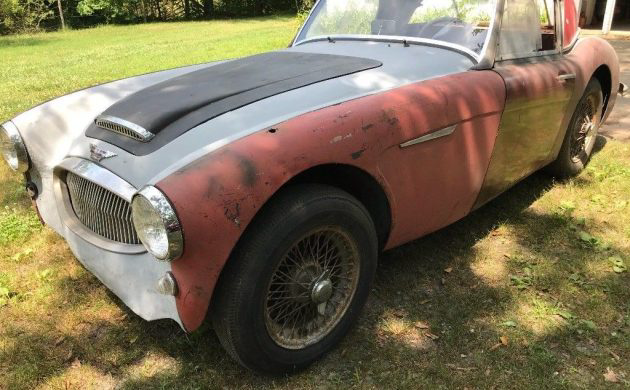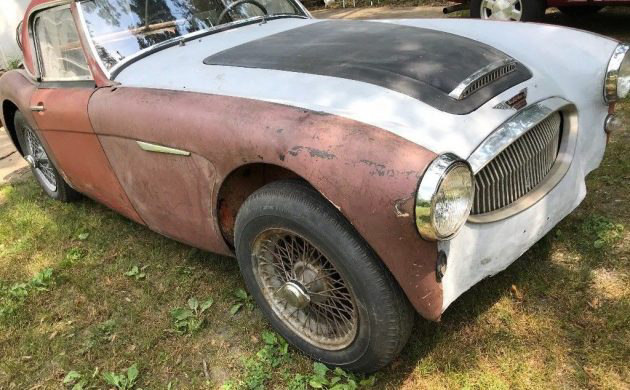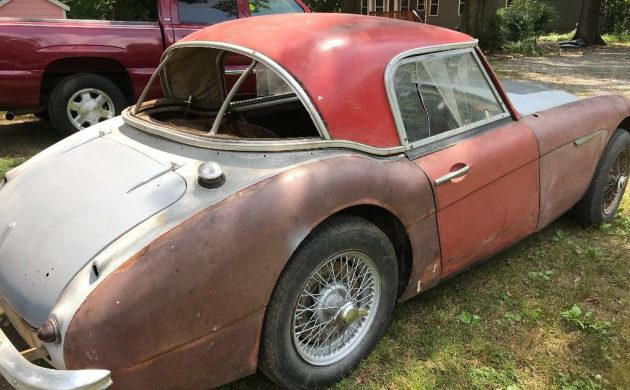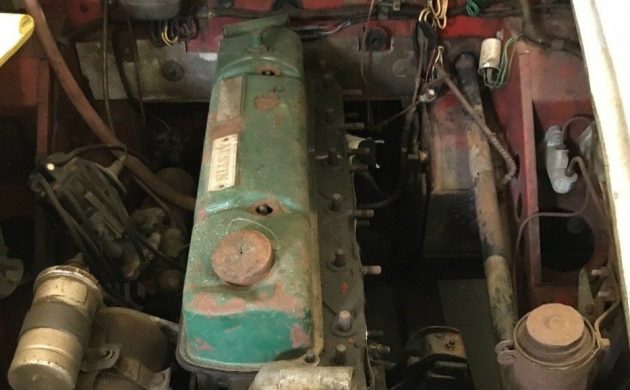Most of the “Big Healeys” we see are either beautiful restorations or rusted away completely. This 1962 3000 Mk. II seems to be right in the middle and it’s being offered for sale here on eBay. Bidding has reached $8,600 but hasn’t met the reserve. The car is located in Powder Springs, Georgia.
The seller doesn’t tell us anything about the body, but the fact that you can see metal at the bottom of the fenders puts it ahead of a lot of Healey restoration projects. I owned, tore apart and eventually sold for someone else to restore (they did) a 1961 3000 in my youth, and given the facts that the shell seems to have been designed to retain water and debris and that part of it (the center front and rear shrouds) is aluminum and the parts bolted to them are steel (google electrolytic corrosion) can make restoration of one of these cars quite daunting.
This is one of the last 3000s with side curtains, but does have the rare factory hardtop. My 1961 did also and it does change the car’s character (it can be removed and the soft top installed. Don’t be completely scared by the absence of a rear window; the originals were clear plastic (hard) and it’s not that difficult to cut and replace.
You’d have some work to do here. Good thing parts are readily available.
This car features the desired tri-carb setup although they are off the car right now, but included. Apart from the lack of a title, this looks like a fairly straightforward project–at least as far as any Big Healey is straightforward! Let us know what you think and be sure and submit any neat finds that you come across!







This is torture, Jamie! Not only a tri-carb 3000, but a later one with the center-shift transmission (the main benefit of which is that internal parts were still available last time I checked).
This one could almost push me over the edge, massive a restoration job as it will be. I’ll just console myself by waiting for a two-seater (BN7), which is what I really want….
I think the center shift gear box is as wrong as the vertical fin grill on this car. Both originated on a newer car.
Pretty sure they’re both correct. I’ve never seen a tri-carb with the old-style (100-6 and early 3000) grill, and all had them by the time the center-shift gearbox was being installed.
I remember the changeover coming in 1961, with production being ended in ’62 when the BJ8 was introduced.
I’m pretty sure they are right also. Short production run with vertical grill, tri carbs and still side curtains. Pretty sure Ray is right also that there was still a two seater available until the “second series” Mark II with the convertible rather than roadster top.
I owned a 1962 tri-carb with center shift, all original. Late cars had them.
In1970 I bought a 1960 3000 two seater drove it a year while constantly repairing it, sold after a year for same money; 1000 bucks. 240z had just come out and I could beat they rolling start 2nd gear but if I had to start in first they had a jump on me. When OD kicked in I shot ahead.. what fun that was.
I’m beyond “pretty sure” they’re correct and will emphatically state they are correct. The ’62 was the last year of the roadster (side screens vs. roll-up windows, straight vs. curved windshield, build-a-top vs. fold-down convertible). Only the earliest ’62’s had the side shift transmission. Most of them had the center shift. Also, ’62 is the first year of the vertical “teeth” in the grill. The 1963, first year of the convertible, was the last year of the silver guages. In ’64, they moved to the walnut dash.
BT-7 (occasional four seater) was the most common, but there were a few hundred BN-7s (two seaters) made. This was the only year of the tri-carb setup (HD6)… they proved very difficult to keep balanced. They replaced with dual HD8 carbs which actually gave it more power.
P.S. – I own a ’62 3000 Mk-II.
I like these but would never buy one, they’re a little to rich for my blood. This restoration will be a marathon everything is going to need to be redone. Good luck to the buyer is all I can say, I’ll stick to Canadian an U.S. Iron where I’m more at home.
Never could understand American and Canadian differences that auto manufacturers created. Dodge front, 56 Plymouth back end, or why Australian cars were not imported with any degree of regularity. How ’bout the Lotus Elise? Couldn’t have it over here for a bit.
I spent a lot of time in Toronto in ’91 and GM Canada showcased the Trans Am Turbo built by Canadians. Hmmmm.
Anyway, for those of us who are of PFM (Pre-Flatulent Muffler) age, a Healey 3000 being driven in anger, is a sound that needs to be recreated or restored. Can’t afford a Merlin? Here ya’ go.
Maybe if I put a glass pack on my 806….
Well some where out there is a Bn7 mark 2 1962 2 place tri carb center shift, one of 144. It had been converted to Buick steel wheels because they would bolt on. I sold the car to a buddy that lived in Buffalo Wyoming in 1970. He has since passed and the Healy has disappeared . It was kept in a barn and I being from Wyoming would periodly check on the car when I came home. So when I see Healy’s advertised I always check even if is the wrong year. Reason for this I sold a 1961 title to a fellow named Tom fromPortland Oregon years age and I have always wondered where that went or what Healy it was applied to.
I knew a professional sports car flipper in Portland many years ago named Tom. If it’s the same guy, then your title was just one of perhaps hundreds to pass through his hands. This was in the pre-internet days, back when Peter Kumar and Gullwing Motors were getting off the ground and the blight that became Beverly Hills Hair Club . . . er Car Club hadn’t even been imagined yet. Missing titles are easy to legally deal with now, that wasn’t always the case.
Same one, I sold him a TR4 1962; and two early Bs, I ask him if he had any interest in an original title of a 1961 Healy and of corse he did so I gave it ti him, alas.
I bought a Tri-Carb Healey like this one in Steel Blue when it was one year old with 19K miles. I guess the British owner who was living in No America liked the car quite a lot to put that many miles on it in one year. I paid about half what he paid for it brand new—$1,850, and it was the best money I spent on anything up to that point.
The car was mostly very reliable, other than the front shocks, which were built into the top front suspension and used a piston-in-oil damping mechanism that tended to wear and lose their damping ability on bad roads, which unfortunately I had to travel on at times. You can probably get then rebuilt now, but back then it was remove and replace.
The sound was fantastic and of course the looks were too. I wish I could buy that car back—like it was, especially when I see a car like this that’s made up of a bunch of panels and parts that look like someone took off of various Healeys and never bothered to R&R properly.
The reserve isn’t met yet but the car and its parts collection will probably get sold at some point, I just hope to a sympathetic soul who actually knows something about these cars and how to get them back together again, properly.
Armstrong lever shocks. So much fun refilling with shock fluid! LOL.
First car I ever bought was a ‘62 Healey 3000 Mk II with the tri-carb engine, and in the same copper color shown on some of the body panels on this car. Bought it in ‘69, it had been heavily abused before I got it, but I put new rod and main bearings in it, had it painted British racing green and continued to abuse it for about a year. Got married and had a son on the way so traded it for a ‘64 Chevelle Malibu SS, also with an abused past…
Memories…Old departed friend had a 62 tri carb,center shift in 1967.Had a lot of fun in that car…trip to Marlboro raceway…first car I drove at age 15…Maybe top on but never the side curtains…car sold and returned to England 20+yrs ago.Now i’m sad,,,,
I’ve always loved these Healeys, but I haven’t focused enough to tell differences between years and models.
What does “center-shift mean”? Does it refer to the location of the shift lever on the tunnel, or something mechanical in the transmission?
It refers to the location of the shift lever, but I believe there are internal transmission differences as well.